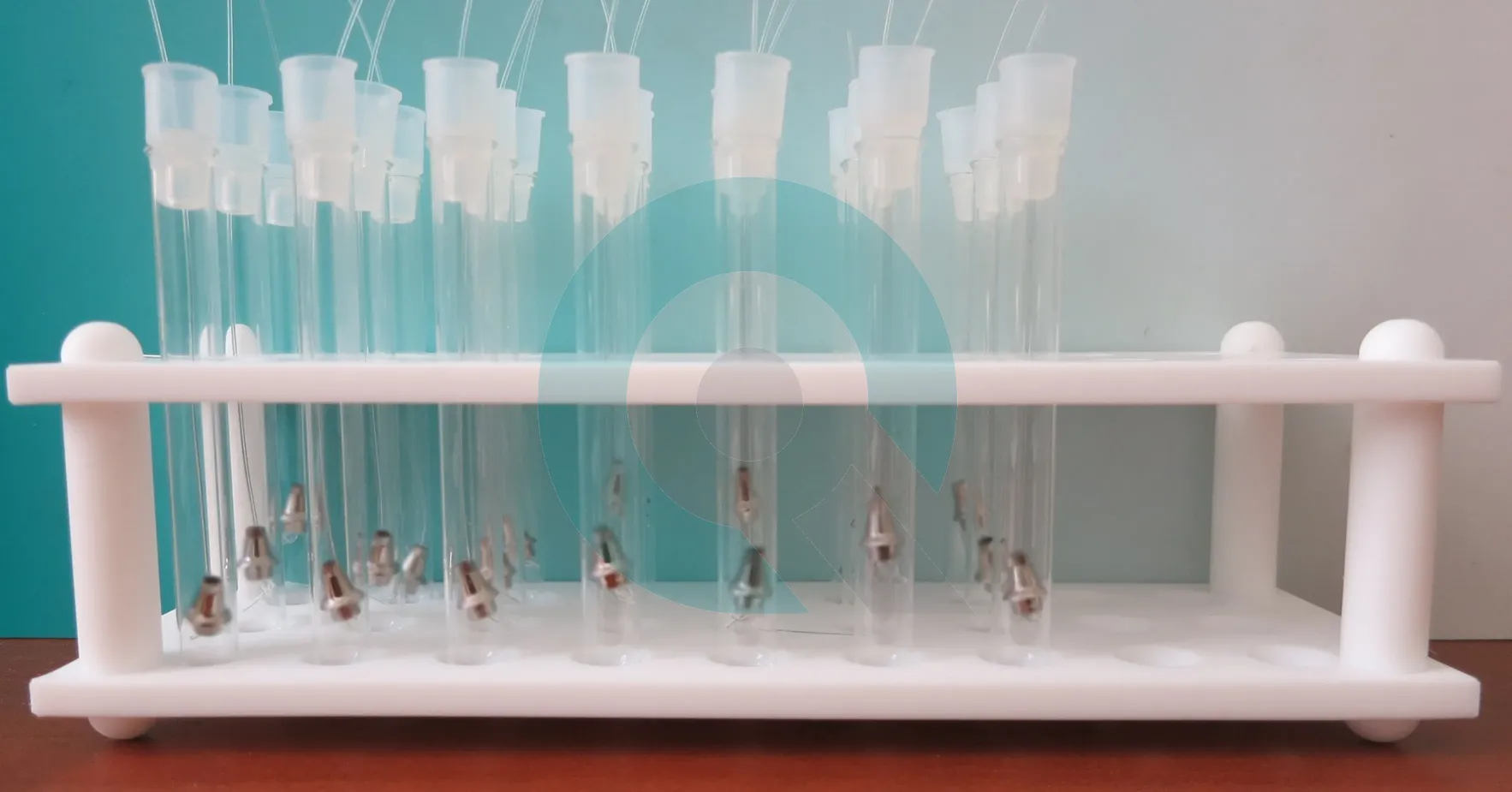Ion Release and Corrosion Test
Corrosion and Ion Release of medical implants like stent, occluder, hip implants and dental
implants can be performed by Questmed GmbH.
We are capable of testing implants to analyse the ion release according to ASTM F3306, ASTM F1875,
ASTM F1877 and ISO 10271.
The nickel leaching of stents is determined in compliance with ASTM F3306.
We also perform electrochemical corrosion tests of implants according ASTM F2129 and ASTM F3044.
ASTM F3306 - Ion Release - Nickel Leaching
ASTM F3306 is a test method utilized for evaluating the ion release - nickel leaching of medical implants, e.g:
- cardiovascular devices,
- endovascular devices,
- orthopedic implants,
- and more.
In this ASTM F3306 test, the medical device is exposed to solutions that simulate the in-vivo environment for a predetermined time frame, with samples taken at specified intervals to measure ion release.
According to ASTM F3306 the test should run at 37°C in bufferd saline solution with a pH-value of 7.4
(corresponding to the pH-value of blood).
It is possible to test in other test solutions like artificial salvia, bile, or urea too.
For devices containing nickel-rich alloys the
FDA recommends measuring concentrations of nickel leached from the device into a fluid at physiologic temperature and pH.
Concentration measurements by ICP-MS are ordinarily taken at specified intervals of 1, 2, 4, 7, 14, 21, 28, 39, 50 and up to 60 days.
Test results are typicly reported as total cumulative release per device in micrograms and as a per day release (μg/day).
These test reports will be accepted by FDA.
ISO 10271 - Corrosion Test of Dental Implants
Questmed executes different tests on corrosion according to ISO 10271. These tests are utilized to determine the behavior of metallic implants in the oral cavity. This determination is a step of an approval process.
Static immersion test
When performing the static immersion corrosion testing of dental implants according to ISO 10271, two sets of test samples will be placed in a aqueous solution constisting of 0.1 mol/l lactic acid and 0.1 mol/l sodium chloride with a pH-value of 2.3 and a temperature of 37 degree for 7 days. Afterwards the medium is analysed by ICP-MS for:
- aluminium
- beryllium
- cadmium
- chromium
- cobalt
- iron
- lead
- manganese
- molybdenum
- nickel
- titanium
- tungsten
- vanadium

Static Immersion Test with Periodic Analysis
The test procedure of this examination is very similar to the static immersion test with the difference that after a fixed amount of days a probe needs do be taken. Sampling occurs after: 1, 4, (7, 14, 21, 28, 35 (recommended)), 42 days.
Sulfid Tarnish Test (cyclic immersion)
In this test two sample devides get dipped for 10-15 seconds once a minute into an aquetic solution of sodium sulfite hydrate. This procedure is repeated for 72 hours. After that timespan we report any surface deteriotation to you.
Sulfid Tarnish test (static immersion)
Like the above, this test procedure tests the implant on sulfide tarnish too.
In difference to the cyclic immersion test the two samples get immersed fully in the test solution of dissolved
sodium sulfide nonahydrate for the whole 72 hours at 37 degree.
Similar to the above described procedure we report any surface deteriotation to you.
ASTM F746 - Pitting or Crevice Corrosion of Metallic Surgical Implant Materials
Questmed determines the resistance of metallic surgical implant materials to pitting or crevice corrosion.
This used as a screening test to rank surgical implant alloys in order of their resistance to localized corrosion.
It's common practice to test multiple samples to ensure statistical significance and reproducibility of the results, so at least 6 samples will necessary.
ASTM F2129 - Cyclic Potentiodynamic Polarization
Questmed determines the corrosion susceptibility of small, metallic, implant medical devices
(vascular stents, ureteral stents, vena cava filters, endovascular grafts, cardiac occluders, aneurysm or ligation clips, medical staples, orthopedic fixation devices),
using cyclic potentiodynamic polarization.
The corrosion susceptibility will be determined according ASTM F2129: Standard test method for conducting cyclic potentiodynamic
polarization measurements to determine the corrosion susceptibility of small implant devices.
At least 6 samples will necessary be warranted based on known variability of corrosion performance according FDA guidance and more samples could be warranted based on the performance of the device and the acceptance criteria.
ASTM F3044 - Galvanic Corrosion
Questmed executes galvanic corrosion tests of implants (stent, occluder) contains more than one type of metal,
such as a base stent material with added markers, to demonstrate the design’s resistance to galvanic corrosion.
If stents will be overlapped during clinical procedures, and these implants are made of different materials,
the potential for galvanic corrosion should be determined according ASTM F3044: Standard test method for evaluating the
potential for galvanic corrosion for medical implants.
Orthopedic plate and screws, hip stem and head, external fixation devices which are of a different alloy may also be evaluated using
ASTM F3044.
Test Setup and Customization
Currently we have 10 test setups for metal ion emission and dental corrosion
testing and one test system for electrochemical corrosion testing.
We are also able to create a testing setup that differs from the ASTM standard if you wish so.
To discuss the best testing situation for you feel free to contact us.
With more than 14 years of experience we will be able to assist and support on your path to an FDA approval.